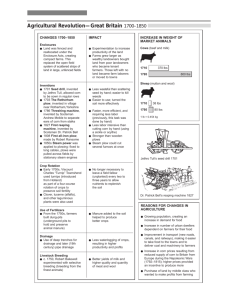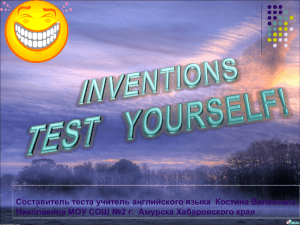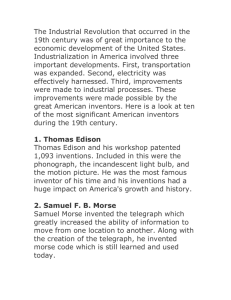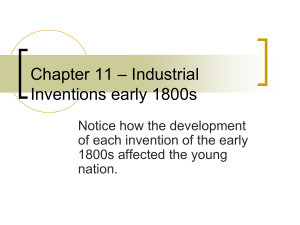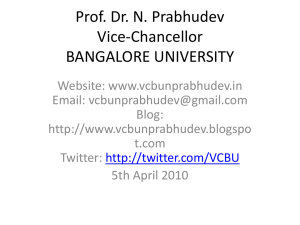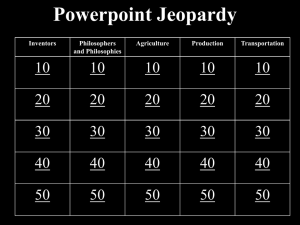Single-Action Army Handgun Telegraph
advertisement
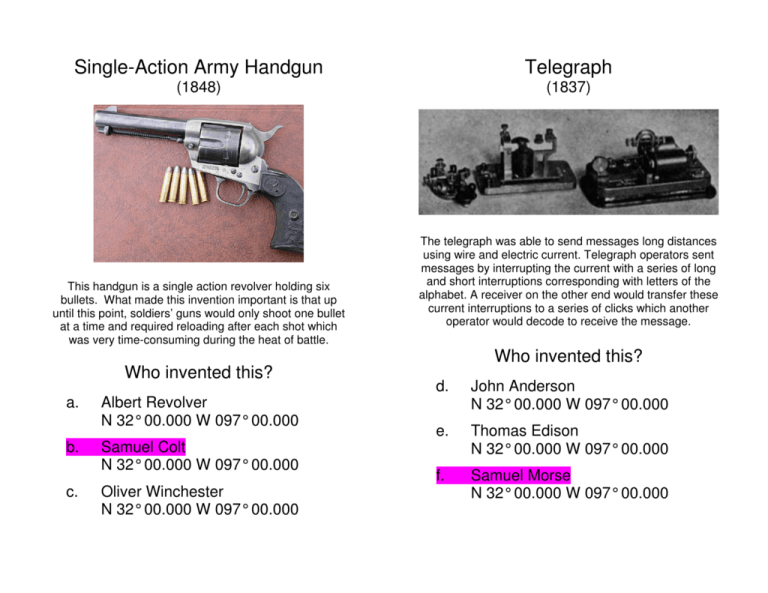
Single-Action Army Handgun Telegraph (1848) (1837) This handgun is a single action revolver holding six bullets. What made this invention important is that up until this point, soldiers’ guns would only shoot one bullet at a time and required reloading after each shot which was very time-consuming during the heat of battle. Who invented this? a. b. c. Albert Revolver N 32° 00.000 W 097° 00.000 Samuel Colt N 32° 00.000 W 097° 00.000 Oliver Winchester N 32° 00.000 W 097° 00.000 The telegraph was able to send messages long distances using wire and electric current. Telegraph operators sent messages by interrupting the current with a series of long and short interruptions corresponding with letters of the alphabet. A receiver on the other end would transfer these current interruptions to a series of clicks which another operator would decode to receive the message. Who invented this? d. John Anderson N 32° 00.000 W 097° 00.000 e. Thomas Edison N 32° 00.000 W 097° 00.000 f. Samuel Morse N 32° 00.000 W 097° 00.000 Self-Polishing Cast Steel Plow Cotton Gin (1837) (1794) The steel plow was invented to meet the needs of the pioneer farmers trying to plow the rich, fertile soil of the Midwest. These farmers had brought cast-iron plows with them from the East where the land was much more light and sandy. The Midwestern soil would stick to the bottom of the plow, and every few minutes the farmer would have to stop to scrape the soil from the plow. After the steel plow was invented, it changed farming tremendously because the soil did not stick to the plow making plowing much easier and faster. Farmers could work much larger fields in the same amount of time. The cotton gin was a machine that separated cotton seeds from the cotton fibers which had previously been done by hand. However, instead of making life easier, it allowed farmers to cultivate much larger plots of land increasing the need for more workers, usually slaves, to grow and pick the cotton. Who invented this? Who invented this? g. Henry Hewitt N 32° 00.000 W 097° 00.000 j. Eli Whitney N 32° 00.000 W 097° 00.000 h. John Deere N 32° 00.000 W 097° 00.000 k. George Washington Carver N 32° 00.000 W 097° 00.000 i. Thomas Jefferson N 32° 00.000 W 097° 00.000 l. Elijah Oliver N 32° 00.000 W 097° 00.000 Lightning Rod Mechanical Reaper (1752) (1831) Lightning rods provide a low-resistance path to the ground that can be used if lightning strikes a structure. Direct lightning strikes are always a fear as they can cause substantial damage to a building and could also cause a fire. The mechanical reaper was a horse drawn farm implement that could cut down wheat more quickly and efficiently. Up until this time, farm workers had to cut down a crop by hand with scythes and sickles. Much more wheat could be grown and harvested and increased productivity by ten times. Who invented this? Who invented this? m. Horace Baker N 32° 00.000 W 097° 00.000 p. Cyrus McCormick N 32° 00.000 W 097° 00.000 n. Charles Oliver N 32° 00.000 W 097° 00.000 q. Edward Lenox N 32° 00.000 W 097° 00.000 o. Benjamin Franklin N 32° 00.000 W 097° 00.000 r. Peter Burnett N 32° 00.000 W 097° 00.000 Airplane Incandescent Lightbulb (1903) (1879) On December 17th, 1803 near Kitty Hawk, NC, history was made with the first powered flight in a controlled aircraft capable to fly by itself. This flight lasted 12 seconds and stretched 120 feet. These brothers’ historic flight marked the beginning of the air age. Although this person didn’t invent the incandescent light bulb, he invented the first practical use of it. He bought the copyright from the original inventors, and then improved on the design to make a bulb last more than a couple of minutes. Before this invention, the best source of lighting was gas lights. They were dirty, got soot all over everything, as well as made the room hotter and uncomfortable. Gas lights could cause fires, and the equipment had to be cleaned almost every day. Who invented this? s. Smothers Brothers N 32° 00.000 W 097° 00.000 t. Wright Brothers N 32° 00.000 W 097° 00.000 u. Baldwin Brothers N 32° 00.000 W 097° 00.000 Who invented this? v. Thomas Edison N 32° 00.000 W 097° 00.000 w. Benjamin Franklin N 32° 00.000 W 097° 00.000 x. George Westinghouse N 32° 00.000 W 097° 00.000
